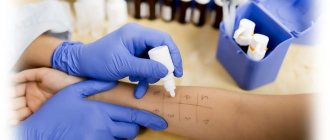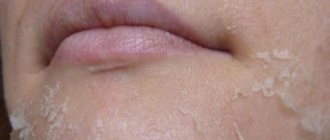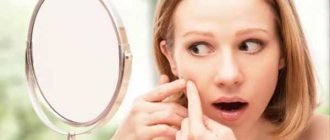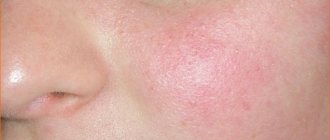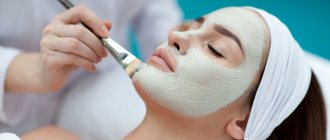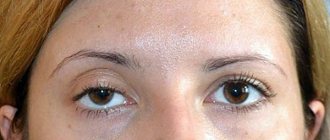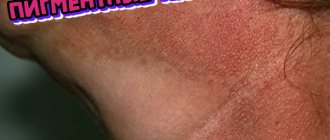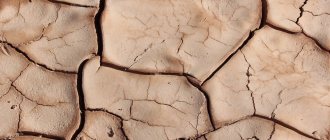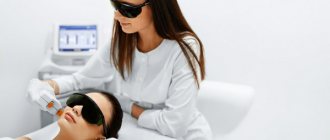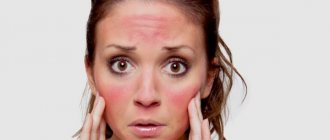Today we will try to answer the question: “After peeling, there are red spots on the face, what should I do?”, which clients often ask cosmetologists.
As you know, peeling is a procedure for cleaning the face, neck, hands and décolleté. This cleansing occurs in the following way: the keratinized layer of dead cells is removed from the skin and toning, cleansing and natural rejuvenation occurs. Most often, this procedure is painless and causes virtually no side effects. But it is enough not to follow just one recommendation or rule, and negative consequences or side effects can practically not be avoided. Not in all cases, after the appearance of such side effects or undesirable consequences, you should contact a specialist. But it should be remembered that with further complications, it is necessary to undergo examination by a dermatologist.
What should you wash your face with and when should you start doing it, and what should you apply to your face after peeling?
- After superficial peeling, you can wash your face 24 hours later, as soon as the skin feels tight and your face becomes shiny, as if covered with a film.
- After the mid-peel, you can wash your face 48 hours later, as soon as a strong feeling of tightness appears and your face is covered with a crust or film.
- You can wash your face with any usual product: gel or foam, but the cleanser should NOT contain abrasive (exfoliating) particles.
- After both types of chemical peeling, you can apply Panthenol spray or the products prescribed to you by your doctor.
The best cosmetics
When caring for your skin, it is better to use proven products. Experts recommend the following cosmetic series and medications:
- pharmaceutical preparations for tissue regeneration;
- cosmetics;
- Israeli cosmetics;
- clay and other products from;
- coolants.
The following names are considered the most popular among pharmaceutical drugs:
- "Troxevasin" (for edema).
- "Panthenol" (for burns, for regeneration after dry cleaning).
- “Depanthenol” (an analogue of the drug above, will help remove severe tightness and post-traumatic redness).
- Natural oils (shea butter or grape seed butter, have an antiseptic effect and eliminate flaking).
- "Lyoton-gel" (anti-redness).
Cosmetic compositions:
- acids for peeling and recovery from;
- glycogel peelings (cleansing + regeneration);
- alginate mask (can moisturize and heal the skin);
- soothing compositions based on aloe.
If you are on a limited budget, you should pay attention to generic pharmaceutical drugs, many of which can be found in your home medicine cabinet. Grapeseed oil is also a relatively inexpensive option.
Is it possible to peel off films and crusts?
DO NOT TRY TO TEAR THEM OFF YOURSELF!!! The exfoliation process should take place gradually and without your participation.
If the loosely dangling edges of the already peeled film are in your way, just carefully trim them with nail scissors.
DO NOT STEAM YOUR FACE to make the film come off faster! There is no need to speed up the process because you risk getting in trouble with your face, but more on that below.
I repeat once again - DO NOT USE SCRUBS! If your “hands are itchy,” tie them behind your back so they don’t reach towards your face!!!!
If it turns out that you accidentally tore off a crust, do not panic, just apply Panthenol spray to this place as often as possible, and call the doctor and tell them about it.
My face is red after peeling, is this normal?
- Redness of the skin after peeling is a normal phenomenon and is determined by the person’s phototype and skin sensitivity. The degree of redness may vary.
- After superficial peeling, the skin may not blush at all, may be pink, or in some cases bright red.
- After the middle stage, the face changes from pink to purple-red. This is normal, as this peeling has a deeper effect on the skin.
- The face should be the reddest in the first minutes after the procedure and gradually lighten. As a rule, after superficial peeling, redness disappears from 30 minutes to a day. After the median - from 12 hours to two to three days.
If the redness of the skin increases with every hour or day, then this indicates an allergic reaction. In such a situation, CALL THE DOCTOR urgently!!!
Home care
At home, you can make medicinal decoctions based on folk recipes. However, you should definitely consult your doctor before use.
You can purchase sea buckthorn oil and apply it to your skin daily, diluting it slightly with water. It is recommended to use an antiseptic (like chlorhexidine) before treatment.
Decoctions of chamomile and calendula have a good effect on the skin. They should be washed 3-5 days after the procedure in the morning and evening, then cleanse the skin with plain water.
Natural honey (liquid) is also used for recovery.
How quickly does peeling appear?
After superficial peeling, peeling appears on the second or third day after the procedure. After the middle one - on the fourth or fifth day.
Girls, don’t be upset if nothing happens to your face the next day!!! In order for the exfoliation process to begin, new skin must grow under the burned skin, and this takes time and does not depend on your desire to “quickly”!
It also happens that after the first superficial peeling there is no peeling - this is also the norm.
This means that the skin has accumulated too many layers of horny cells that the peeling could only affect the topmost ones, which you washed off while cleansing the skin and didn’t even notice. In such cases, continue the prescribed course. Peeling will appear after the following procedures.
How to remove redness, relieve swelling, and eliminate other consequences?
The best chemicals and medications
Will help remove the effects of peeling:
- For redness - “Bepanten”, “Sintomycin”, etc.
- Advantan and Metrogyl will relieve irritation.
- For burns - Panthenol, etc.
ethnoscience
Compresses from the decoction will help relieve redness and swelling of the face.:
- calendula;
- sage;
- chamomile;
- parsley
They relieve irritation and have an antiseptic effect.
10. Is it normal for the face to burn after the procedure and for water blisters to appear?
Here it is important to distinguish between the two concepts “burning” and “burning”. When your face is “on fire,” you simply feel a rush of blood and warmth to the skin. When the skin “burns,” there is a tingling sensation, as if the acid is still on your face.
- In the first case, everything is fine and the feeling of “burning” in the face gradually calms down within 30 minutes to an hour.
- If the burning sensation on your face does not stop after the doctor has completed the procedure, then you need to inform him about it immediately!
- If small water bubbles appear on the skin after peeling, CALL YOUR DOCTOR immediately! This is not the norm, it shouldn’t be like this! Either you have a deeper burn or an inadequate skin reaction. At best, it’s an exacerbation of herpes.
But after peeling there SHOULD BE NO Blisters!
Consequence-based care
To prevent scarring and deterioration in appearance, patients who have undergone peeling need to attend a course of epidermal rehabilitation, taking into account individual characteristics. The best advice will be given by a professional cosmetologist who is familiar with all the characteristics of your skin. However, you can choose the right remedies for side effects yourself by following the instructions below.
Peeling
Peeling of the skin is a natural reaction of the body to the cleansing procedure. The skin begins to renew itself. Peak exfoliation occurs 48-60 hours after the procedure. The side effect discussed in full goes away within a week of exposure. If irritation and rolling of skin particles does not stop, you should consult a doctor.
For long-term complications, do not neglect to see a doctor. In a clinic you can see a dermatologist, in a private salon you can see a cosmetologist who specializes in skin restoration.
To quickly remove peeling, it is necessary to use preparations with hyaluronic acid. In the first three days it can only be light foams and lotions for washing. Next, you can move on to a natural face mask, but applying greasy cream to the skin is prohibited.
Preparations with hyaluronic acid are easy to find in cosmetic stores. They come in any price category. The most budget-friendly options are teenage anti-acne lotions, but it is better to use a specialized product for post-peeling recovery. Biorevitalization can help.
Hyperemia
Hyperemia is the scientific term for redness of the skin. This consequence is typical for patients who have undergone enhanced peeling. If a girl suffers from hypersensitivity, the symptom can last up to 2 weeks, and itching of the skin is possible.
It is not advisable to use tonal compositions to visually eliminate the problem. Light powder is allowed, but only after consultation with a cosmetologist. It is better to take multivitamins, which will speed up skin regeneration, and use gels with a healing effect.
For a while, you should avoid any activities that cause a rush of blood to the head. You cannot lie with your head down for a long time, do aerobic exercise, or drink alcohol and energy drinks. Warming drugs and spicy seasonings are prohibited. You can anoint your face with a cooling agent.
Edema
Edema occurs mainly in girls with a predisposition to this problem (patients with plumpness, a rounded face, and impaired functional functioning of the liver and kidneys). The main method of combating edema is to avoid salty and sweet foods and reduce water consumption for 2-3 days. It is recommended to consume foods with natural antioxidants: green tea, fruits.
It is also necessary to use local preparations with regenerating properties. It is recommended to purchase special anti-edema medications. They also cool the epidermis well, reducing itching and redness.
What are the complications after peeling?
If the peeling is carried out correctly by a competent doctor (For information on how to find such a specialist, read the article How to find a good cosmetologist?), then this is only 20% of the successful result!
Yes, I'm not exaggerating. 80% of the success of this procedure is what you do during the rehabilitation period!
Always follow your doctor's orders. I beg you very much, do not engage in amateur activities! Don't sit on forums and don't ask your friend, husband, neighbors for advice - CALL YOUR DOCTOR.
If you realize that something is going wrong, call your doctor again; it’s better to have a false alarm than to deal with complications later:
- hyperpigmentation (obvious darkening of some areas of the skin) is characteristic of fair skin
- hypopigmentation (strong lightening of skin areas) is typical for dark or tanned skin
- erythema (prolonged, persistent redness of the entire skin or some areas)
- telangiectasia, rosacea (appearance of dilated blood vessels on the surface of the skin)
- scars (in the most extreme cases) are almost never seen
All this can be fixed, but it’s better to prevent it!!! Therefore, follow your doctor's recommendations!!! If in doubt, write to me.
After peeling, even more acne appeared, herpes appeared, what should I do?
When treating acne, an exacerbation of rashes often occurs - this is normal, the body is fighting the infection. As a rule, this happens only after the first peelings, and by the end of the course there is no trace left of them. Just stay the course and be patient!
Exacerbation of herpes occurs not only after chemical peeling, but also after tattooing and contouring. During these procedures, immunity “falls” and a “cold” appears.
There is no need to panic, just call your doctor, he will prescribe the necessary medications. And before the next procedures, you will need to take pills to prevent exacerbation.
Sun traps
According to Natalia Polonskaya, it is still wrong to draw direct parallels between anti-aging procedures, the sun and skin pigmentation disorders. There are people who do not give such a reaction, even immediately after peeling when exposed to the sun. For others, the first rays of sunlight are enough for the appearance of freckles and spots. There are several main reasons for the appearance of pigmentation disorders.
Why is my face not red and a film does not appear after retinoic peeling?
Retinoic (yellow) peeling is a medium-impact peeling, but its mechanism is different from TCA peeling.
Retinoids are synthetic analogues of vitamin A, which stimulates the natural renewal of skin cells every 28 days. During this time, the cells gradually peel off layer by layer, unnoticeably to us.
But retinoids speed up the skin renewal process by up to two weeks, as a result of which we may notice the process of peeling, as this occurs in a larger volume in a short time.
Therefore, the face is not covered with film, since there is no initial damage to the cells.
My history
“Look, no matter how much you have to walk under a veil all your life,” I received such friendly parting words several years ago, when I decided to try fractional laser rejuvenation.
“Well, stay with your strawberry and cucumber masks,” I joked. I did not believe at all in their miraculous power, capable of smoothing out wrinkles and tightening the face. On the contrary, she believed in high technology. And it was this technique, studied far and wide, that seemed to me the best choice. The procedure was done by the best specialist, in late autumn. The result exceeded all expectations. However, summer came, the sun warmed up, and it was discovered... Even if not a veil, but a wide-brimmed hat and “sun protection” of at least SPF 50 - that’s my lot. But even they are unable to prevent the fact that the previously even and golden tan has now been replaced by light spotting. In some places it is lighter, in others it is darker. And the whole face (toned up and without wrinkles) generally looks motley due to pigmentation disorders. In a word, beauty, and nothing more. After taking a closer look and talking with those around me, I discovered that I was not the only one facing this problem. “The Motley Case” can be safely opened in relation to resurfacing, dermabrasion and chemical peels, which are very popular today. And the latter, by the way, are recommended today as an off-season procedure. “Pigmentation after peeling and other procedures does occur, and quite often,” explains Natalia Polonskaya. – Even if some traumatic procedure was done before summer, the skin still remains activated for a long time - it is characterized by increased activity of melanocytes. These skin cells, which produce the pigment melanin, can react to increasing heat, climate change and other factors. And if the procedure takes place during a period of high solar activity, the risk of pigmentation disorders increases even more. Therefore, with regard to many technologies that injure the skin (electrical, laser and photoepilation, laser resurfacing, photorejuvenation, effects on blood vessels, etc.), an immutable rule applies - their season begins in October and ends in March. As for pigmentation after peeling, you need to clearly understand their classification according to the depth of impact. Peels that damage living epidermal cells in the sunny season can only be done if there are compelling reasons, after weighing the possible risks and benefits. Peels with exfoliation within the stratum corneum of the epidermis can be done without a summer break, but with an interval of at least 7-14 days.
How long will it take for the skin to fully recover after peeling?
- After superficial treatment, the face should return to normal in 7-10 days. If two to three weeks have passed and you still have redness, age spots or something else, then CALL YOUR DOCTOR urgently!
- After the median, the skin recovers in 3-4 weeks, sometimes up to a month and a half. If after 2 months the skin has not returned to normal and does not look as usual, CALL YOUR DOCTOR!
- In both cases, something went wrong and the help of a cosmetologist is required to prevent complications.
